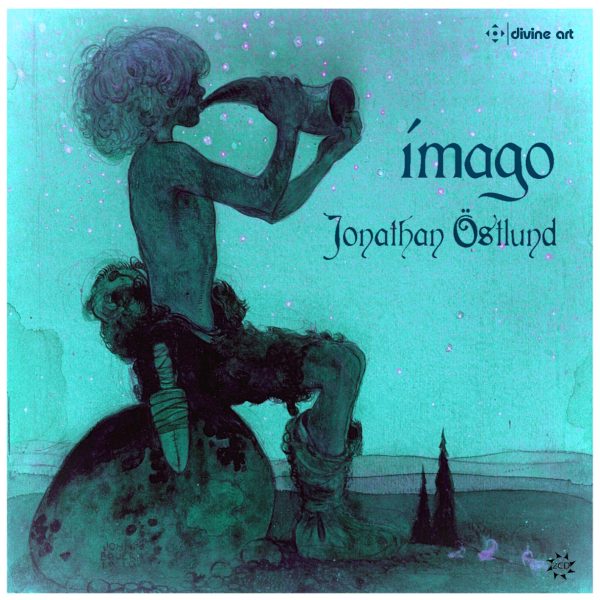Fanfare
Back in Fanfare 39:4, I enjoyed a similar Divine Art twofer of Swedish composer Jonathan Östlund’s music. The current release certainly continues the trend: this is music of filigree beauty; his mind a magpie, taking sources from the music of Bach, Mussorgsky, Tchaikovsky, Beethoven, Brahms, Reger, Debussy and Swedish and Celtic folk music. The whole traces a journey through the seasons.
We certainly feel the fragranced flute of Pan in L’eau de l’oubli (Anna Noakes, flute, with Gabriella Dall’Olio), and there’s no missing the Bach D-Minor Toccata that opens the Fantasia on that theme (Sasha Grynyuk, piano) or the loveliness of Östlund’s take on Bach’s Siciliano. In the astonishingly confusing personnel listing I am afraid I am unable to locate the excellent flutist for Les oiseaux et françois, but whoever it is is a fine player.
Although I enjoy the sound world of the arrangement of Reger’s Maria Wiegenlied, sadly I cannot warm to Lina Ferencz’s mezzo, which is lacking warmth of tone; she is more convincing in the vocalises (La neige de Noël, La nuit étoilée, and Rêve et lune).
One of the most clever pieces here is Östlund’s Paraphrase on Komm susser Tod, Komm sel’ge Ruh’, a lovely cross-pollination between Bach and Östlund in lush textures. His piece on Beethoven’s “Moonlight” first movement, Mondspiegel, well played by Sasha Grynyuk, is perhaps of lesser inspiration, and I do wonder why there is quite so much reverb to the recording of Turquoise Spring for violin and viola. That’s a pity, as the performance (Paola Nervi and Elena Saccomandi) is of gossamer lightness, the piece full of flights of fancy.
It’s interesting to find a choral piece suddenly installed here, Night of June (a Swedish text translated by the composer). Sadly, it’s a rather gray and uninteresting setting; congratulations are due to the choir for negotiating Östlund’s difficult harmonies, though. The pleasant, Debussyan Lumières du Jardin, sensitively played by Walter Gatti, offers a place of realignment, and the two bassoon and piano piece Will-o ‘-the-wisp offers light amusement, curiously sounding as if it is about to burst into a carol at any moment. This is apt, as the final piece on the first disc is indeed a fantasia on a Swedish carol by Vilhelm Serve-Svensson, Midnight Hour, an absolutely delightful, light-touch retelling (with some superbly fluent piano playing also). The first disc closes with Zephyr, a solo piano piece played by Evgheny Brakhman that is more forthright than its title might imply.
Östlund’s setting of Gustaf Froding in Titania is well done, but the sound feels over-reverbed again. More playful and in a better recording is Swedish Folk-Dance for two clarinets (only one is listed, Christine E. Hoerning, so I have to assume it is multi-tracked). The shorter pieces here are atmospheric and well done; it’s nice to have a bed of strings for soprano Maria Zagorinskaya’s vocalise, La sirena (which includes some lively horn playing from Oleg Egorov). If Castel Caracal, another vocalise, is rather filmic, there’s no missing “Scarborough Fair” in True Love of Mine (it’s a fantasia for piano on that theme).
The only extended piece on the twofer is Banquet, a suite for two clarinets (again presumably multi-tracked)—amusing and light, if somewhat over-reverbed again. Here Östlund’s ability to act as a magpie comes in handy again: Starting with a “Fantasia on a Swedish Folk-Song,” we have two clarinet takes on a Brahms Hungarian Dance, Debussy’s Faun, Mussorgsky’s “Promenade” and “The Old Castle” from Pictures, Tchaikovsky’s “June” from The Seasons, plus a “Fantasia on “The Last Rose of Summer.” Everything, both composition and performance, could be summed up by the word “deft.” Most intriguing of the seven movements is the last, “Fantasia on Tchaikovsky’s June,” where one really does get the impression that Tchaikovsky is being taken for a walk. More robust is Traumgewalt, beautifully played by Caroline Doerge, who manages not to break her tone at all and has all the fluency required. If the song The Jester somewhat outstays its welcome, the solo flute La flûte rèveuse is Östlund’s Syrinx, and Myriam Hidber-Dickinson is in top form; some recorded birdsong enhances Imago Theme 2. Certainly this is a pleasant way to spend a couple of hours. Östlund’s music is highly beautiful, and he is lucky to have such a skilled group of performers
@divineartrecordingsgroup
A First Inversion Company
Registered Office:
176-178 Pontefract Road, Cudworth, Barnsley S72 8BE
+44 1226 596703
Fort Worth, TX 76110
+1.682.233.4978






![Listen to the full suite of Marcel Dupré’s Variations Sur un Noël, Op. 20 from Alexander Ffinch’s #Expectations release today! listn.fm/expectations [in bio]](https://scontent-dfw5-1.cdninstagram.com/v/t51.71878-15/588904367_2327488161082898_8709236950834211856_n.jpg?stp=dst-jpg_e35_tt6&_nc_cat=105&ccb=7-5&_nc_sid=18de74&efg=eyJlZmdfdGFnIjoiQ0xJUFMuYmVzdF9pbWFnZV91cmxnZW4uQzMifQ%3D%3D&_nc_ohc=gQOLjaATqEIQ7kNvwEFSjku&_nc_oc=Adn0XCeivCWjiBMPkWkQQ0W3eeDiGJzjwa85KpwCnXKrRULY3CehpJbj3fhkyiXcdEg&_nc_zt=23&_nc_ht=scontent-dfw5-1.cdninstagram.com&edm=ANo9K5cEAAAA&_nc_gid=G8orLhr5r1JRyO9B-inNWQ&oh=00_AfnLReRjLTMrg_usXRLmSB6Q9uXABK1opt5plw_BywAElQ&oe=69483A2A)

![“the ‘Manteca’ Paraphrase – a rare foray into the two-piano medium but here played double-tracked – exudes a panache of which Dizzy Gillespie would surely have approved.… [a] recital well worth investigating.” —Gramophone Magazine with high praise for Ophelia Gordon's debut release, Kapustin: Between the Lines!](https://scontent-dfw5-3.cdninstagram.com/v/t51.82787-15/598796470_18303255136283342_540941604740887837_n.jpg?stp=dst-jpg_e35_tt6&_nc_cat=108&ccb=7-5&_nc_sid=18de74&efg=eyJlZmdfdGFnIjoiRkVFRC5iZXN0X2ltYWdlX3VybGdlbi5DMyJ9&_nc_ohc=sFsWUr2jc5wQ7kNvwGEAGrL&_nc_oc=Adm8n4-CnWQ1L7WlONOYe1EoOwbhqFDQqPNb1NjETWvFsIqMrne92r3WaJdzRmc0dto&_nc_zt=23&_nc_ht=scontent-dfw5-3.cdninstagram.com&edm=ANo9K5cEAAAA&_nc_gid=G8orLhr5r1JRyO9B-inNWQ&oh=00_Afm2cjgG418BZ3r9QdRDibJxawBiUsamls35L2c5bRzL4A&oe=69481484)



